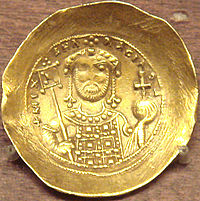Nikephoritzes
Nikephoritzes (
Biography

Nikephoritzes was born in the Bucellarian Theme and entered service in the imperial secretariat under Emperor Constantine IX Monomachos (r. 1042–1055). Under Constantine X Doukas (r. 1059–1067), he was sent away from the court to assume the governorship of Antioch, because he allegedly slandered the Empress Eudokia Makrembolitissa, accusing her of adultery. Following the emperor's death and her assumption of the regency, he was imprisoned.[1][2][3] He was released by the new emperor, Romanos IV Diogenes (r. 1068–1071), and appointed as praetor (civil governor) of the combined themes of Hellas (Central Greece) and the Peloponnese.[1][2] On the assumption of power by Michael VII in 1071, Nikephoritzes was recalled to serve in the imperial government by the new emperor's uncle, the Caesar John Doukas, who valued his administrative skills. Back in Constantinople, Nikephoritzes was appointed logothetes tou dromou, and his power grew rapidly. Not only did he soon sideline the other ministers, including the hereto powerful Michael Psellos, but in autumn 1073, Nikephoritzes forced the Caesar himself to withdraw from active participation in the governance of the Byzantine Empire and retire to his estates.[1][2][3]
As the de facto ruler of the Byzantine Empire, Nikephoritzes set about reorganizing the state, trying to restore its strength and re-establish central control. His first priority was to replenish the treasury. For this he resorted to brutal taxation, which caused major hardship both in the provinces and in Constantinople. He also established a central warehouse (phoundax) at
Nikephoritzes also tried to reform the army, and revived the regiment of the
Opposition coalesced around the
Nikephoritzes fled the capital and sought refuge in
References
- ^ a b c d e f g Kazhdan 1991, p. 1475.
- ^ a b c d e f g h Prosopography of the Byzantine World 2011: "Nikephoros 63".
- ^ a b Angold 1997, p. 121.
- ^ Angold 1997, p. 122; Stephenson 2000, pp. 99–100.
- ^ Angold 1997, pp. 121–122; Stephenson 2000, pp. 98, 100.
- ^ Angold 1997, pp. 117–121, 123.
- ^ Angold 1997, pp. 121–123.
- ^ Angold 1997, pp. 123–124.
- ^ Kazhdan 1991, pp. 1475, 1815; Angold 1997, p. 124.
Sources
- Angold, Michael (1997). The Byzantine Empire, 1025–1204: A Political History. London: Longman. ISBN 978-0-582-29468-4.
- ISBN 0-19-504652-8.
- Prosopography of the Byzantine World (2011). "Nikephoros 63". Retrieved 26 November 2011.
- Stephenson, Paul (2000). Byzantium's Balkan Frontier: A Political Study of the Northern Balkans, 900–1204. Cambridge: Cambridge University Press. ISBN 0-521-77017-3.
